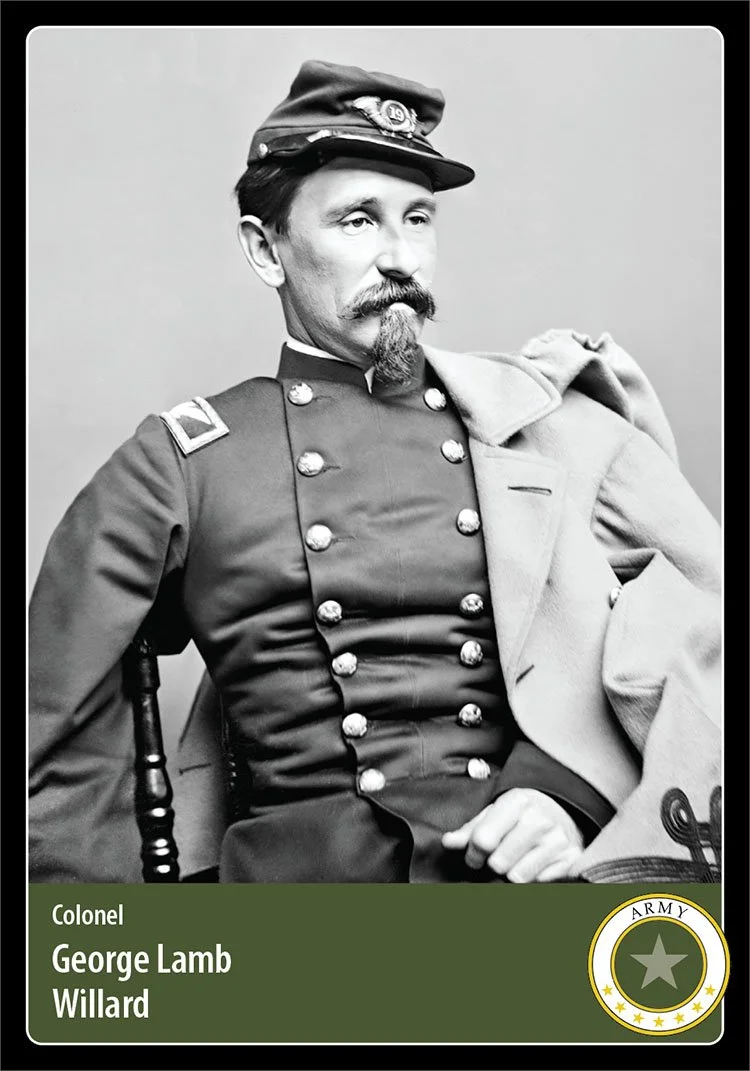Hero Card 161
Photo retrieved from Library of Congress (digitally restored), Public Domain
Hometown: New York, NY
Branch: U.S. Army
Unit: 125th New York Volunteer Infantry; in command of the 3rd Brigade, 3rd Division, 2nd Corps, Army of the Potomac
Date of Sacrifice: July 2, 1863 - KIA at Gettysburg, Pennsylvania
Age: 35
Conflict: Civil War, 1861-1865
According to Willard family genealogy, George Willard was born on the island of Manhattan in New York City on August 15, 1827, to John Moses and Susan (Lamb) Willard. He enlisted in the United States Army when his father died.
Willard served with distinction in the Mexican-American War (1846-48) and was cited for gallantry in the Battle of Chapultepec (September 12-13, 1847). In 1848, he received a commission as Lieutenant in the 8th U.S. Regular Infantry—on the personal recommendation of Major General Winfield Scott.
In 1854, Willard married Mary Gould Plum, the daughter of banker and businessman Elias Plum of Troy, NY.
Despite not having attended West Point, Willard gained considerable military experience and rose to the rank of Captain before the outbreak of the Civil War in 1861. When the call went out from the U.S. government for two-year Army volunteers, Captain Willard raised the 2nd New York Volunteer Regiment—expecting to be named its Colonel.
At the time, however, regulations prohibited regular Army officers from commanding volunteer troops. Unwilling to resign his rank, Willard instead served with the 19th U.S. Infantry, seeing action in the Peninsula Campaign in Virginia (March-July 1862). Willard would rise again to the rank of Major.
As the Civil War grew larger, the need for experienced officers became more acute. The regulations against regular Army officers commanding volunteer regiments were changed, and George Willard was named Colonel of the 125th New York Volunteers in August 1862—his 35th birthday.
According to America’s Civil War magazine: “His regiment was attached to a brigade of other New York units—the 39th, 111th, and 126th—that only weeks later was captured humiliatingly at Harpers Ferry, VA. The regiments were soon paroled, some of the men earning the derisive nickname ‘Harpers Ferry Cowards’ within the Army of the Potomac.”
A few days before the Battle of Gettysburg (July 1-3, 1863) in Pennsylvania, Col. Willard was given command of the 3rd Brigade, 3rd Division, 2nd Army Corps.
On the second day of the battle, July 2, 1863, Confederate General William Barksdale's Mississippi regiment charged and punched a large gap in the Unions Army’s Cemetery Ridge defenses.
Col. Willard rallied his men with cries of “Remember Harper’s Ferry!” The men fixed bayonets and launched a successful counterattack. The timely arrival of Willard’s brigade repelled the rebel charge and contribute greatly to the Union victory—at one of the most important engagements of the Civil War.
As his 3rd Brigade was returning to Cemetery Ridge, Col. George Lamb Willard was struck in the head by a shell and killed instantly.
Fort Willard was later named in his honor. The hastily-built fort was the southernmost of 63 forts built by the Union Army to defend the nation’s capital, as the threat from Confederate forces loomed.
In 1888, a small monument was dedicated on the Gettysburg battlefield spot where he fell.
Sources
America’s Civil War: 12 Forgotten Heroes of Gettysburg—Colonel George L. Willard
Sons of Union Veterans of the Civil War: Col. George L. Willard, Camp #154, Albany, NY
Times Union, Oct. 31, 2022: SEEN: Col. George L. Willard gravesite rededication
Gettysburg Stone Sentinels: The Battle of Gettysburg, George Willard
Oakwood Cemetery: George Lamb Willard
Burial Site: Find a Grave
Educate future generations, instill gratitude, honor the fallen. Join the Mission!





